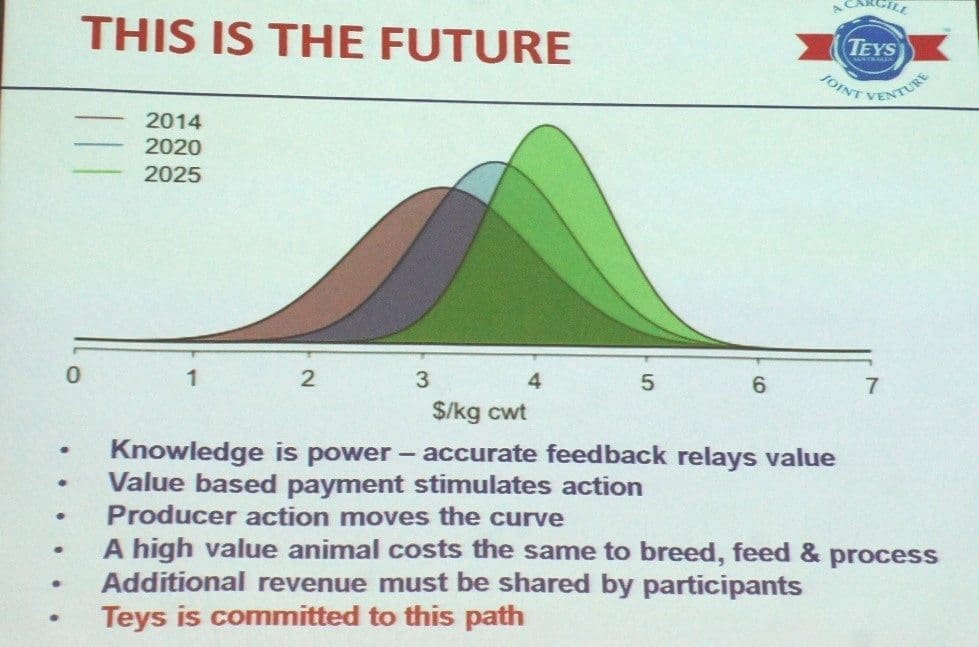BUILDING producer trust in value-based marketing systems, including elements like lean meat yield and offal value, is the next big challenge faced by processor Teys Australia as it moves along a pathway towards VBM adoption.
Speaking at the Angus Australia annual conference in Ballarat last week, Teys general manager of corporate services, Tom Maguire said carcase feedback on lean meat yield would start to filter back to producers in coming weeks, as the company continues to develop its vision to move towards VBM.
 Mr Maguire told the conference audience, mostly made of up of seedstock producers, that genetics would play an absolutely critical role in any industry gains in carcase yield that might unfold.
Mr Maguire told the conference audience, mostly made of up of seedstock producers, that genetics would play an absolutely critical role in any industry gains in carcase yield that might unfold.
Beef Central first wrote about Teys’ vision to move down the VBM path in this article published in October, 2015.
Paving the way towards objective yield assessment, the first DEXA X-ray equipment installation will take place at Teys’ Lakes Creek plant near Rockhampton in Central Queensland, in a process that is due for completion by the end of July.
The next installation would happen at Teys Wagga facility in NSW, Mr Maguire said. Once that is completed, the company would be in a position to very quickly prove the technology across different types of cattle and environments, and would then look at installation at other company processing sites.
He said producers would shortly start to receive carcase feedback sheets with three additional columns, providing information on lean meat yield percentage, MSA index, and value-based marketing group.
At first, yield information will be provided using a calculation based on an equation, but before long the objective DEXA X-ray technology will deliver that data.
“There won’t be any move to changing payment systems for perhaps three years”
Mr Maguire stressed that the provision of yield performance information would not change how Teys currently pays its livestock suppliers any time soon.
“There won’t be any move to changing payment systems for perhaps three years,” he said.
“That’s not the purpose of this. The purpose at this point is to provide information to allow producers to better understand yield, and perhaps make changes, and only then can we start talking about changing payment systems.”
“We need to talk a lot, to make sure all stakeholders understand what the feedback means, and are comfortable with it. It’s through these conversations that we can start to show what we do, to help you (producers) do what you do. If we don’t get the relevant information back to producers in a usable form, we’ve failed in our objective,” he said.
“But we’ll be really excited to talk more with producers about the potential of genetics to improve performance in yield, and even potentially in areas like reducing dark cutting. Producer action can move the curve on yield, and carcase value,” he said.
The ‘bell curve’ on current industry yield performance was presented in this graphic, together with a ‘tighter, higher yielding’ prediction that might happen by across the cattle population by 2025, based on the signals coming back to industry over yield performance.
In simple terms, Value-Based Marketing was really about being able to communicate the true value of each animal sold to suppliers, Mr Maguire said.
“It sounds simple in theory, but certainly a little more difficult in practise, and its certainly not something that the industry has been doing up to now,” he said
If real change was going to be made in the industry, it was important to have ‘lots of conversations’ about what was involved with VBM, to get the process started.
He presented four key reasons why a move to VBM would help the industry:
- First was the typical commodity cycle, where either processor or producer was doing well, while the other was not. That model was simply not sustainable. “We need more and more money invested in our industry by all stakeholders, and more stable returns are required in order to achieve that, rather than a roller coaster,” he said.
- Australian beef’s cost structures, with labour costs well above international competitors, and spiralling energy costs. Changes in gas and electricity costs, if Teys did nothing in the next 12 months, would add $10 million to the company’s energy bill, he said. “That gets absorbed, and it works out at about $8 a head.”
That puts Australia at twice the cost to process grainfed cattle as North America, and twice the cost to process grassfed cattle as South America.
“It’s no secret that our processing costs are about $300 a head, while in contrast in China, the cost is more like $120 a head,” Mr Maguire said. “We’re starting to get pushback around the world, and particularly Brazil, is producing cheaper product.”
“The point in all this is that Australian beef cannot compete on price, and nor should we. Our beef belongs in different, higher-value markets, where customers are seeking particular characteristics in their beef.”
“The other competitor, of course is competing proteins. Beef today has the distinction of being four times the price of chicken. What that means is our retailers are shrinking the amount of beef offers in front of consumers, and growing the amount of chicken. Beef becomes more of a special occasion item, and any special occasion item has to perform really well, and consistently.”
Mr Maguire said it was a ‘real credit to leadership within the industry’ that people were getting out there and thinking about the future when faced with such challenges, and how the Australian industry can do things better – through developments like the DEXA objective carcase yield assessment technology.
“If we don’t continue to make an effort to evolve, those challenges like competing proteins and cheaper overseas export competitors are going to start to catch up with us,” he said.
Mr Maguire said at the centre of the VBM movement was the need to understand that every dollar producers and processors generated in their businesses ultimately came from the people consuming the product.
“Our collective job, as an industry, is to aim to give them exactly what they want, every time. If we can do that, they will pay as much as they can pay for the product. Unless we can give them something for that special occasion that does fit the bill each time, we suffer.”
He said the answer was really ‘pretty simple.’
“We should be able to figure out the yield of the carcase, the quality of the carcase and multiply them to deliver value. That is value-based marketing in a nutshell.”
But we are nowhere near achieving that, right at the moment. What currently happens is that all mobs of cattle coming into the Teys business, include a ‘normal distribution’ – some good, some not so good.
“What the industry currently does is pay on the average. We don’t help you sort out what’s good or bad. But the actual performance of the individual animals is dramatically different to the grid average return,” he said.
Mr Maguire displayed a graph showing real value of individual animals in a mob (including yield value) ranging from about 425c/kg to 600c/kg carcase weight – a variance of 175c/kg.
The trick in value-based marketing is sorting that out, and pay on an individual animal basis.”
“We can put a DEXA machine in a meat plant, but it is just a black box. All stakeholders have to have confidence in the outcomes”
“In order for that to happen, we’re first going to have to get out and talk to people – and build trust in the systems. This is not a technology problem – technologies like DEXA will help us enable some of these things, but if we don’t get out and talk with suppliers and build trust, then nothing will change.”
“We can put a DEXA machine in a meat plant, but it is just a black box. All stakeholders have to have confidence in the outcomes, and confidence to make management decisions to improve performance.”
“The only reason we want to provide you (producers) with yield feedback is to allow you to make good genetic decisions about what you do with your cattle. It’s about enabling producers to deliver an animal that does what the consumer wants, in terms of an eating outcome.”
Mr Maguire said current industry calculations of lean meat yield were only about 30pc accurate, meaning they were ‘not particularly useful’ for decision-making purposes on-farm.
“The move to a new equation based yield assessment will give a better indication, of where a beast sits in the population for lean meat yield, which is what’s being rolled out in feedback to some producers in coming weeks. But the next step, DEXA, is really accurate in its yield prediction, narrowing down that variation.”
But Mr Maguire warned that the provision of yield feedback could not develop into a situation where producers ‘chased yield’, at the expense of quality traits.
The pork industry, in the past, had targeted yield at the expense of quality, at considerable cost through consumer ‘push-back,’ he said.
Animal health feedback, by way of offal condition, will be another part of the expanded feedback cycle being launched soon by Teys.
Mr Maguire said the new DEXA technology – along with whatever other technology came along that was used to objectively predict yield – would be validated by AusMeat, using CT scanning as a calibration benchmark.
“Producers can be confident that no matter which DEXA machine is used, the yield assessment will be the same,” he said. “Each machine will be calibrated every day.”
Widespread uptake of VBM?
An Angus conference attendee asked Mr Maguire how long it would take for the VBM payment model to spread across the industry – assuming the trial work and DEXA technology all proved reliable.
“Ultimately producers should demand this type of stuff,” he said.
“That’s because all our futures – producers and processors are linked together. All processors in this country access the same cattle and the same markets that we do. But we want to force this through, because it’s the chicken industry and the pork industry that I’m most worried about.”
Tomorrow: Are Australian slaughter cattle getting too heavy?




HAVE YOUR SAY